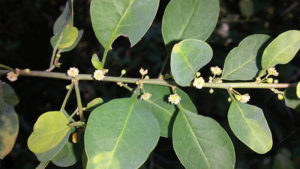
Name: Helinus integrifolius (Lam.) Kuntze
Family: Rhamnaceae (Buckthorn-family)
Common names:
Engl. Soap Bush, Soap Creeper, Soap Plant
Afr. Seepbos, Seepbossie
Xho. Ubulawu, Ubhubhubhu
An oneirogen plant!
Description
Sprawling climber. Tendrils are unbranched. Leaves ±30mm, blade thin, tips blunt, rounded, with short, sharp protuberance. Flowers are in few-flowered inflorescences; flowers small, white to green (October-April). Fruit three-lobed, ±8mm, tipped with remains of calyx.
Conservation status
According to the SANBI (South African National Biodiversity Institute) Red List of South African Plants, Helinus intergrifolius was not selected in any one of four screening processes for highlighting potential taxa of conservation concern for detailed assessment and was hence given an automated status of Least Concern (LC.) (redlist.sanbi.org)
Distribution and habitat
Integrifolius is found in bushveld and rocky wooded places. Provincial distribution: Eastern Cape, Free State, Gauteng, KwaZulu-Natal, Limpopo, North West and Western Cape.
Derivation of name and historical aspects
Helinus derives from elinus meaning a twiner and integrifolius means the leaves with smooth unbroken margins. Ubulawu derives from ukulawula, meaning to interpret dreams. Ubhubhubhu means quick, fast, or in the shortest possible time, and refers to the rapid action of the medicine in overpowering harmful medicines or witchcraft.
Ecology
Helinus integrifolius is host plant for butterfly larvae.
Uses and cultural aspects
Used as ritual body wash and an emetic and believed to bring good luck and positive results in court cases, exams, competitions, etc. It is an ubulawu (dream-inducing) plant used by some clans in rituals to facilitate communication with ancestors.
How to grow climbers
Helinus integrifolius is climber. Climbers are spectacularly showy but surprisingly low maintenance, provide simple landscape solutions to a range of garden problems and are particularly useful in small spaces. Use them to soften a bare wall or cover a plain fence, creating a view where none exists such as in a courtyard or at the side of a house. Read more about the climbers: www.handyman.net.au/how-grow-climbers
References and further reading
Dold, T., Cocks, M. 2012. Voices from the Forest, Celebrating Nature and Culture in Xhosaland. Jacana Media, Sunnyside, Auckland Park, South Africa.
Pooley, E. 2005. A Field Guide to Wild Flowers, KwaZulu-Natal and the Eastern Region. The Flora Publications
Trust, c/o Natal Herbarium, Botanical Gardens Road, Durban 4001.


